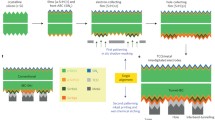Abstract
The boron doped multi-crystalline silicon (mc-Si) ingots were grown using the directional solidification process. Grown ingots were converted into bricks and then to wafers. We have fabricated silicon solar cells from the multi-crystalline silicon wafers. The minority carrier lifetime of the wafers is around 15–25 µs. The effect of back contact annealing temperature has been investigated. Annealing the device at 5830 C for 5 s gives better results. Typical open circuit voltage (Voc) of the devices is around ~ 540-550mV. The best cell had a power conversion efficiency of ~ 9 % with a typical acceptor doping density ~ 2.35 E + 15 per cm3 (The devices reported here do not have AR coating layer, no passivation was done and the surfaces are also not textured).
Similar content being viewed by others
Data Availability
All data added in the manuscript.
References
Lin KM, Lin HH, Dandage HK, Du YC (2019) Pseudo colorization of electroluminescence images of multi-crystalline silicon solar cells for defect inspection. Mod Phys Lett B 33(14&15):1940010
Photovoltaics report (2020) Fraunhofer Institute for Solar Energy Systems, ©Fraunhofer ISE: Photovoltaics Report, updated: 16 September 2020
Yadav TS, Sharma AK, Kottantharayil A, Basu PK (2018) Low-cost and low-temperature chemical oxide passivation process for large area single crystalline silicon solar cells. Sol Energy 169:270–276
Cui M, Jin C, Zhuge L, Wu X (2019) The impact of diffusion gettering on solar cell efficiency and light induced degradation. Optik 181:129–133
Chan C, Hamer P, Bourret-Sicotte G, Chen R, Ciesla A, Hallam B, Payne D, Bonilla RS, Wenham S (2017) Instability of increased contact resistance in silicon solar cells following post-firing thermal processes. Solar 1(11):;1700129
Peral A, Dastgheib-Shirazi A, Fano V, Jimeno JC, Hahn G, Canizo CD (2017) Impact of extended contact cofiring on Multicrystalline silicon solar cell parameters. IEEE J Photovolt 7:91–96
Chan CE, Payne DN, Hallam BJ, Abbott MD, Fung TH, Wenham AM, Tjahjono BS, Wenham SR (2016) Rapid stabilization of high-performance Multicrystalline P-type silicon PERC cells. IEEE J Photovolt 6:1473–1479
Wu S, Wang W, Li L, Yu D, Huang L, Liu W, Wua X, Zhang F (2014) Investigation of the mechanism of the Ag/SiNx firing-through process of screen-printed silicon solar cells. RSC Adv 4:24384–24388
Peral A, Lelièvre JF, Recart F, Cañizo CD (2012) Defect engineering during the contact co-firing step in an industrial belt furnace. Phys Status Solidi C 209(10):2107–2110
Fukano. K, Hamdi. A, Dhamrin M, Kamisako K (2011) Temperature characteristics of dark i-v curve in crystalline Silicon solar cells. The 21st International Photovoltaic Science and Engineering Conference November 28th - December 2nd, 2011, Fukuoka, Japan
Rakotoniaina JP, Al Rifai MH, Breitenstein. O (2004) Quantitative analysis of the influence of shunts in solar cells by means of lock-in thermography. 3rd World Conference
Ebong. A, Hankey. D, and Yang.L (2013) Developing the next generation low-cost inks for high efficiency multi crystalline silicon solar cells, High Capacity Optical Networks and Emerging/Enabling Technologies 66–71
Schultz O, Glunz SW, Willeke GP (2004) Multicrystalline silicon solar cells exceeding 20 % efficiency. Prog Photovolt Res Appl 12:553–558
Kalyan. A DD, Utpal SJ,SD. G (2021) Effect of diamond-like nanocomposite as antireflection layer on multi-crystalline silicon solar cells. Mater Today Proc 39(5):2046–2049
Weipeng. RT, Z, Ximan. K, Zhongwei DL (2021) Influence of surface structure on the performance of mono-like Si PERC solar cell. Mater Sci Semicond Process 126:105662
Jeong EP, Donggun L (2021) Optimization of laser fired contact process for the formation of an Al-BSF layer. Appl Sci 11:2689
McIntosh KR, Honsberg CB (2000) The influence of edge recombination on a solar cell’s i-v curve. 6th European Photovoltaic Solar Energy Conference
Ali Ibrahim (2011) Dark current -voltage characteristics and lock-in thermography techniques as diagnostic tools for Monocrystalline silicon solar cells. Int J Renew Energy Res 1(3):60–65
Breitenstein O, Langenkamp M (1998) Lock-in contact thermography investigation of lateral electronic inhomogeneities in semiconductor devices. Sens Actuators A 71:46–50
Crotty G, Daud T, Kachare R (1987) Front surface passivation of silicon solar cells with antireflection coating. J Appl Phys 61:3077
Ruby D, S, Zaid S, H, Narayanan S (2000) Plasma-texturization for multicrystalline silicon solar cells. Twenty-Eighth IEEE Photovoltaic Specialists Conference. https://doi.org/10.1109/PVSC.2000.915756
Acknowledgements
This work was supported by the Ministry of New and Renewable Energy (MNRE), the Government of India (Order. no: 31/58/2013–2014/PVSE & 15-01-2015). The authors are thankful to Prof. K. L. Narasimhan and Prof. B. M. Arora, National Centre for Photovoltaic Research and Education (NCPRE), IIT Bombay for useful discussion. NCPRE at IIT Bombay sanctioned PUMP program to Mr. G. Aravindan, resulted in this research. G Aravindan acknowledges Human Resource Development Group, Council of Scientific & Industrial Research for Direct Senior Research Fellowship, Government of India (Sanction letter no/file no: 08/542(0010)2K19 EMR-I).
Funding
Ministry of New and Renewable Energy (MNRE), the Government of India (Order no: 31/58/2013–2014/PVSE & 15-01-2015).
Human Resource Development Group, Council of Scientific & Industrial Research for Direct Senior Research Fellowship, Government of India (Sanction letter no/file no: 08/542(0010)2K19 EMR-I).
Author information
Authors and Affiliations
Contributions
Following authors have contributed
G. Aravindan,
S. Sanmugavel,
S. G. Nagarajan,
V. Kesavan,
M. Srinivasan,
P. Ramasamy.
Corresponding author
Ethics declarations
Ethics Approval and Consent to Participate
Not applicable.
Consent for Publication
Not applicable.
Competing Interests
No.
Conflict of Interest
The authors have no conflict of interest.
Research involving Human Participants and/or Animals
No.
Informed Consent
Not applicable.
Additional information
Publisher’s Note
Springer Nature remains neutral with regard to jurisdictional claims in published maps and institutional affiliations.
Rights and permissions
About this article
Cite this article
Aravindan, G., Sanmugavel, S., Nagarajan, S.G. et al. Influence of Back Contact Annealing Temperature in the mc-Si Solar Cell Fabrication Process. Silicon 14, 9751–9762 (2022). https://doi.org/10.1007/s12633-021-01356-1
Received:
Accepted:
Published:
Issue Date:
DOI: https://doi.org/10.1007/s12633-021-01356-1



